+Search query
-Structure paper
| Title | Structural and functional properties of different types of siphonous LHCII trimers from an intertidal green alga Bryopsis corticulans. |
|---|---|
| Journal, issue, pages | Structure, Vol. 31, Issue 10, Page 1247-11258.e3, Year 2023 |
| Publish date | Oct 5, 2023 |
 Authors Authors | Zhenhua Li / Cuicui Zhou / Songhao Zhao / Jinyang Zhang / Xueyang Liu / Min Sang / Xiaochun Qin / Yanyan Yang / Guangye Han / Tingyun Kuang / Jian-Ren Shen / Wenda Wang /   |
| PubMed Abstract | Light-harvesting complexes of photosystem II (LHCIIs) in green algae and plants are vital antenna apparatus for light harvesting, energy transfer, and photoprotection. Here we determined the ...Light-harvesting complexes of photosystem II (LHCIIs) in green algae and plants are vital antenna apparatus for light harvesting, energy transfer, and photoprotection. Here we determined the structure of a siphonous-type LHCII trimer from the intertidal green alga Bryopsis corticulans by X-ray crystallography and cryo-electron microscopy (cryo-EM), and analyzed its functional properties by spectral analysis. The Bryopsis LHCII (Bry-LHCII) structures in both homotrimeric and heterotrimeric form show that green light-absorbing siphonaxanthin and siphonein occupied the sites of lutein and violaxanthin in plant LHCII, and two extra chlorophylls (Chls) b replaced Chls a. Binding of these pigments expands the blue-green light absorption of B. corticulans in the tidal zone. We observed differences between the Bry-LHCII homotrimer crystal and cryo-EM structures, and also between Bry-LHCII homotrimer and heterotrimer cryo-EM structures. These conformational changes may reflect the flexibility of Bry-LHCII, which may be required to adapt to light fluctuations from tidal rhythms. |
 External links External links |  Structure / Structure /  PubMed:37633266 PubMed:37633266 |
| Methods | EM (single particle) / X-ray diffraction |
| Resolution | 2.55 - 2.74 Å |
| Structure data | EMDB-34883, PDB-8hlv: EMDB-34930, PDB-8hpd:  PDB-8hq8: |
| Chemicals |  ChemComp-0UR: 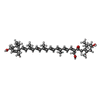 ChemComp-0IE: 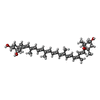 ChemComp-NEX: 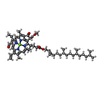 ChemComp-CHL:  ChemComp-CLA:  ChemComp-LHG: 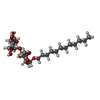 ChemComp-LMU:  ChemComp-MG:  ChemComp-BET:  ChemComp-LMG:  ChemComp-HOH: |
| Source |
|
 Keywords Keywords |  PHOTOSYNTHESIS / light-harvesting complexes / siphonaxanthin / siphonein PHOTOSYNTHESIS / light-harvesting complexes / siphonaxanthin / siphonein |
 Movie
Movie Controller
Controller Structure viewers
Structure viewers About Yorodumi Papers
About Yorodumi Papers




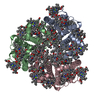

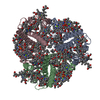
 bryopsis corticulans (plant)
bryopsis corticulans (plant)